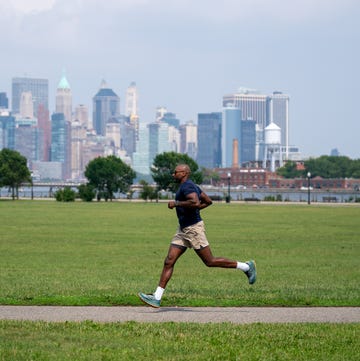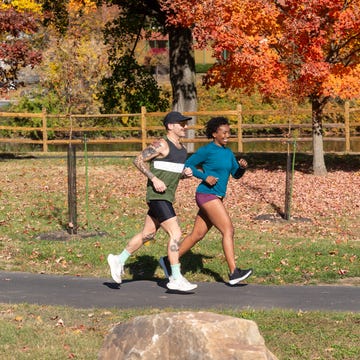Like any high-level athlete, marathoner Emily Sisson feels the pressure before a big event. But she has a secret weapon, as she pointed out at the medal ceremony after placing second in 2:22:42 at the 2024 U.S. Olympic Marathon Trials: “I’m married to a therapist,” she said. “So he helps a lot with that stuff.”
Sisson met Shane Quinn, a mental health counselor who’s working on his Ph.D. in psychology, when both were track and cross country All-Americans at Providence College; the two married in 2018. Quinn’s dissertation is on motivation in sports, and he hopes to work with athletes on issues like anxiety, depression, and stress management.
For right now, alongside his remote studies at Grand Canyon University, the Irish-born Quinn is a critical part of the support team for one of the best distance runners in the country. Though he’s careful to remember that he’s her husband and not her mental health professional—if he forgets, she’ll rib him for using his “therapist voice”—his expertise comes in handy for helping Sisson prepare for races like the Olympic Marathon in Paris on August 11.
“It’s a lot of understanding her—that just comes from me being her partner—and then using my own perspective to help set her up mentally as best as I can,” Quinn said. Here’s what you can learn from the way they’ve fine-tuned her mental approach to training and racing.
Take Downtime Between Training Cycles
Sisson ran the Chicago Marathon last October and placed seventh and first American, in 2:22:09, despite developing a side stitch along the way. The turnaround before training for the Trials in February was tight, and the timing also meant she didn’t spend the holidays with her family. “That’s just kind of a bummer,” she told Runner’s World in June.
So after the Trials, the New Balance athlete took a few weeks off to visit family, see her friends, and have more dinners out with Quinn. “Things I don’t always have energy for when I’m marathon training,” she said.
Taking that moment to reset doesn’t always come naturally to Sisson. “She’s the most driven person I’ve ever met,” Quinn said. “You can’t just switch your personality and be like, ‘Okay, now I’m not like that.’” So he, along with her parents, sisters, and coach Ray Treacy, remind her that those longer breaks are a critical part of training.
“You are investing so much emotional and psychological energy, and obviously physical energy, in what you’re doing that you can’t actually do it forever,” Quinn said. Especially in endurance sports like running, “it’s not the hardest worker in the room that wins all the time. It’s the people who work hard and are smart with their bodies as well.”
Have Confidence in Your Training
No matter how diligently you train and prepare, race day always brings a unique set of challenges. That’s especially true in the marathon. Few athletes, Sisson included, ever reach 26.2 miles on a training run, so they must have confidence they can handle the distance based on the accumulation of everything else they’ve done.
After heading to Paris to preview the Olympic marathon course in March, Sisson and Quinn adopted a similar mindset about the hills—including the estimated 10.5-percent grade just after mile 18. “I don’t know how to describe it,” Sisson said. “It’s such an extreme element.”
When they returned, Quinn told coach Treacy: “I don’t know about simulating any of this, because it’s already very hard, what she does,” he said. “That’s too much.” Instead, to ensure she’s ready for the course but not injured or overtrained, Sisson is combining extra gym work to strengthen her quads with more moderate uphill and downhill runs to callus them. “It’s finding the right balance,” she said, and she’ll draw confidence from that on race day.
Shift Perspective During a Hard Workout
Quinn has long paced many of Sisson’s workouts—previously on foot, and now by bike. When things get hard, he’s always there with a dose of humor and positivity. “Sometimes he just reminds me to keep my eyes on him and he will do all the pacing,” Sisson said. “Other times he will drop some words of encouragement,” often pointing out something that’s going well.
One tactic he takes is to remind Sisson of the purpose of the workout and how it fits into the bigger picture. For example, when doing mile repeats, she often worries when she’s a few seconds behind the assigned pace.
Quinn emphasizes that the main goal is to get her legs turning over so she can surge to cover a move in a marathon—the exact numbers aren’t that critical. “Oftentimes that’s a good thing for her to focus on,” he said. “She might end up, ironically, hitting the paces that she wants after that too, because she’s not just thinking about how terrible she feels.”
Keep Your Mind (and Hands) Occupied During the Taper
Every runner knows the particular form of restlessness that comes in the final countdown to a long race. “The last 10 days of the taper can be pretty stressful, because you’ve just had about 10 weeks of more mileage than you’re used to, then all of a sudden you’re done,” Quinn said. “You have this surge of energy and you just want to go conquer the world, but you can’t … instead, you’re supposed to eat more, keep hydrated, and sit down more.”
In the buildup to the 2022 Chicago Marathon—where she wound up running 2:18:29 to set an American record—Sisson was feeling especially antsy. So Quinn thought of a unique way to quiet her mind: He bought her a Lego set. “I found doing something hands-on helped me disconnect and focus on a small, simple task in a relaxing way,” Sisson said. “It felt very grounding.”
Before the Trials this year, she switched to a puzzle her mom sent her, which depicted the Cliffs of Moher in Ireland. Playing board games or video games can work too, Quinn said—anything that engages your mind without stressing your body.
Revisit Your Past Successes
Because three of Sisson’s four marathons have been on flat, fast courses—she debuted with a 2:23:08 in London in 2019, in addition to running Chicago twice—she has a reputation as a runner who’s more suited to speed than tough conditions. That’s something that could have easily rattled her before the Trials, where Florida’s heat was an issue, or get into her head for Paris.
Quinn tries to head this off by reminding Sisson of times she’s crushed more challenging routes, such as the 2023 Falmouth Road Race, a 7-mile run on a hilly course.
“She was second to [Boston and New York City Marathon champion] Hellen Obiri in that race, and she was eating up the ground on all the competitors, flying up and down,” he said. She was also “a kick-ass cross-country runner” in college. “She’s brilliant on every type of course. You can’t be as good as her without being that way.”
Make a Race Plan That Works for You
Some athletes do extensive visualization before a race, picturing not only themselves but also their competition. That way, they feel they’ve prepared for every scenario.
But through the years, Quinn and Sisson have learned that she doesn’t need to worry about who she’s running against or what they might do. Rather, she does her best when she can break the race into small chunks and focus on each one in succession. “She wants a very simple race plan,” he said. “It’s like, tell me where to be at mile 1, mile 8, and I’ll figure out the rest myself.”
Having the self-awareness about which strategy works for you can help you set yourself up for success, too. Even better? Get a partner or buddy like Quinn who can remind you of what you’ve done well and what you’re capable of in the future.
“The important thing for her is to keep it simple and race as tough as I know she will, and as smart as I know she will, on what’s going to be a very challenging course for everybody,” he said.
With that approach, no matter where she places in Paris, she can consider the day a success.

Cindy is a freelance health and fitness writer, author, and podcaster who’s contributed regularly to Runner’s World since 2013. She’s the coauthor of both Breakthrough Women’s Running: Dream Big and Train Smart and Rebound: Train Your Mind to Bounce Back Stronger from Sports Injuries, a book about the psychology of sports injury from Bloomsbury Sport. Cindy specializes in covering injury prevention and recovery, everyday athletes accomplishing extraordinary things, and the active community in her beloved Chicago, where winter forges deep bonds between those brave enough to train through it.














